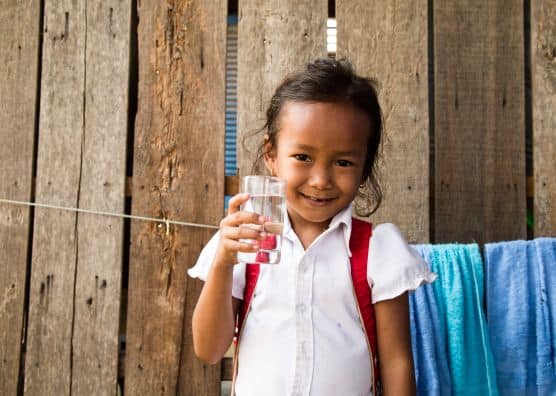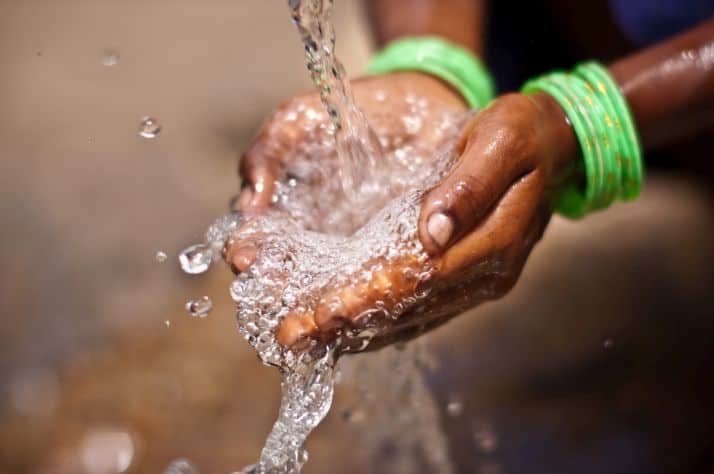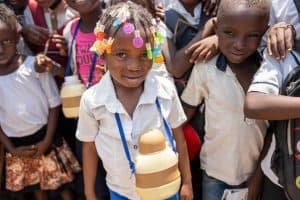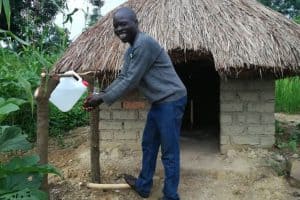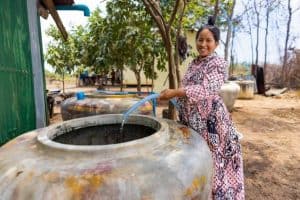Samaritan's Purse's Water for Kids trips to Cambodia are helping to build water filters for schools.
by Jeff Adams, director of communications and creative services, Samaritan’s Purse Canada
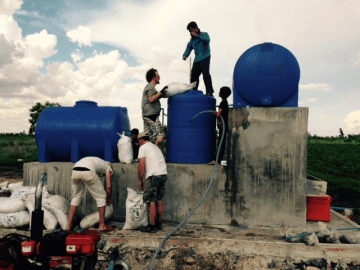
Pouring bags of gravel and sand into the water filtration tank.
May, 2015—For more than a year I’ve regularly walked by the life-size model of a school water filter in Samaritan’s Purse Canada’s Calgary offices, I’ve never stopped to closely study it.
But now that I’m in Cambodia for two weeks as part of a team of Canadian volunteers helping to install school filters, the technology—and its impact—have definitely caught my attention.
When we arrive at each rural school site, Samaritan’s Purse has already poured a thick two-tiered concrete platform, installed water lines inside the foundation to accommodate more than a dozen water taps and provided three large blue plastic tanks.
Two tanks are designed to sit horizontally, and one vertically. It takes three of us to lift one of the horizontal tanks onto the platform’s top level. The 1,500-liter vessel is large, awkward and very hot to the touch in the almost 50C heat. We’re sweating profusely as we position it correctly and drill holes for PVC pipes.
This upper tank stores the raw unfiltered water. In most cases, the raw water comes from a nearby pond or dug-out rain reservoir. In others it will be trucked to a school site.
Next, we lift the vertical—or filtering— tank into place and drill more holes for PVC pipes. The pipes will permit water to flow from the raw-water storage tank into the filtration tank. We also connect and place more PVC pipes on the bottom of the filtration tank so when water has been filtered downward, it will flow into the third and final tank, which stores the filtered water.
Once we have all three tanks in place, we tear open several bags of gravel, rinse the gravel with water we brought with us, and pour it into the filtration tank (the one in the middle). We repeat the process, this time with bags of sand, until the filtration tank is about half full. Then we begin pumping gallon after gallon of raw water into the filtration tank to clean the gravel and sand as much as possible.
We know we’re making good progress when the dark gray water flowing out of the filtration tank when we began becomes now relatively clear. We’ll allow the remaining water in the filtration tank to sit for about two weeks so a scummy “bio-layer” of micro-organisms forms on top.
The bio-layer combines with the layers of gravel and sand to create a highly effective filtration system that quickly transforms potentially deadly raw water into safe, drinkable water for the hundreds of students and staff at each school.
When the bio-layer has fully formed and the entire filtration system is fully functional, the water that flows out of it will be stored in the filtered-water storage tank so students and school staff can safely drink it or wash their hands with it whenever they want.
We won’t be in Cambodia long enough to see that happen at the three schools where we installed filters. But we were able to visit another school where an earlier group of Samaritan’s Purse volunteers from Canada installed a filter a few weeks ago.
That school’s water source is a stagnant pond, filled with lily pads and surrounded by thick mud. But after flowing through the Samaritan’s Purse filter, the water is safe and drinkable. Our entire team watched with delight, and more than a few tears of joy, as the students ran out of school during their recess, turned on the taps to fill their water bottles, drank as much as they wanted, then ran off to play.
It made all the hours of assembling the filters, under Cambodia’s blazing sun, well worth it.
“We need clean water so badly for our children so they can be healthy and go to school,” said Bok Pot, a leader in one of the three desperately poor villages where our 11-member team installed school filters. “Samaritan’s Purse is the only organization that has come here to help us.”
To God be all the glory.
Do you want to join a Samaritan’s Purse “Water for Kids” team and build school filters in Cambodia?


